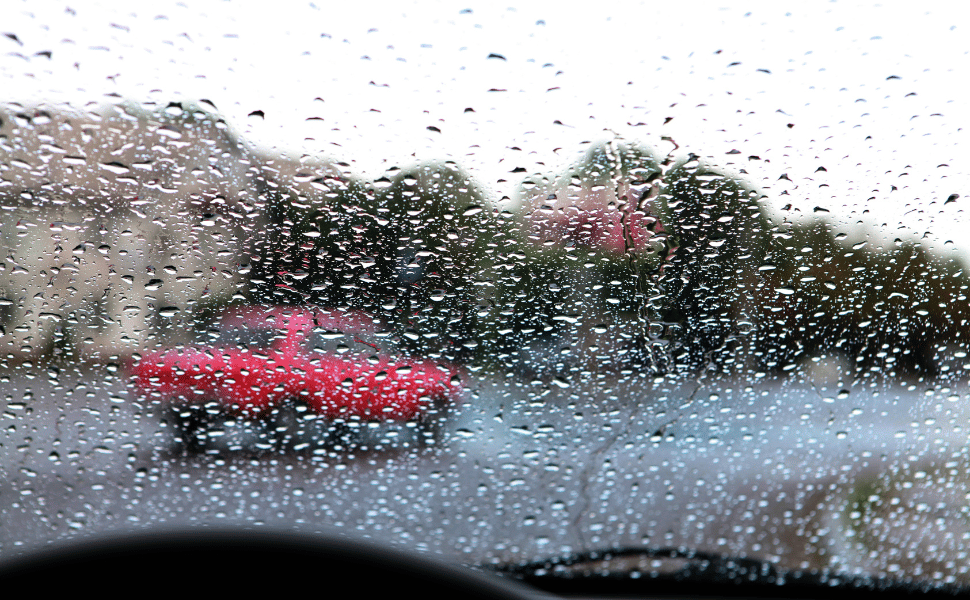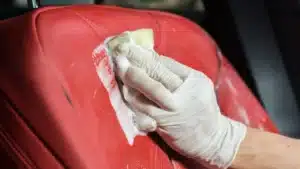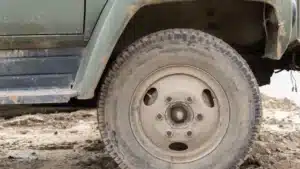Water stains on your car’s windows might not cause harm to the vehicle itself, but they can be exceptionally challenging to remove.
The bad news is that water stains are almost impossible to avoid. After all, you can’t dodge every raindrop. These marks can be frustrating if you value a spotless, shiny car.
The good news is that there are plenty of methods for removing the spots, and many of them are quite straightforward and won’t take more than a few minutes to complete once you have the right tools and technique. In this article, you will learn how to remove water stains from car glass

What Causes Hard Water Spots on Your Window?
The water itself does not actually cause the stain on your glass. Instead, it is the minerals in the water, which remain behind after the drops evaporate.
Rain can cause these markings on your glass, or you could get hard water spots from washing your car at home or at an automated or self-service car wash that doesn’t fully dry the windows afterward. Other common incidents, like driving through a lawn sprinkler, getting up-splash from puddles, and water dripping off roofs or gutters can cause these pesky spots.
Types of Water Stains on Windows
Hard water stains are by far the most common type on car windows. These off-white spots appear after the glass gets wet and then dries. The water leaves behind a calcium and magnesium deposit, which causes the mark.
Left untreated, hard water stains can cause etching on your windows. This is when the minerals can actually bond with the glass and be harder to remove. If the water has chemicals, you may experience a similar phenomenon called chemical etching. Some products and techniques can remove both types of stains, but you are best served by finding a technique that works and using it often to keep your glass clear.
How to Remove Water Spots from Car Windows and Windshields
If you have an issue when water spots on windshield won’t come off, the best idea is to start with the most straightforward (and cheaper) technique for removing them and move to more aggressive ones with specialized products if the first efforts don’t work.
Vinegar
The advantage of vinegar is that almost everyone has it around their home. Its acidity can help you remove water stains.
Here’s what you’ll need
- A spray bottle.
- 1 cup of vinegar.
- 1 cup of water.
- A cloth.
You need to mix the solution before application.
- Mix the vinegar and water in the spray bottle and stir well.
- Spray the mix directly on the window.
- Let it sit for a minute, then wipe it aggressively with a cloth.
- You can repeat the process two or three times if needed.
You can tip the mixture ratio in favor of vinegar if the marks have been on the window for a few days or more.
Steel Wool (Grade #0000)
Steel wool is a useful tool for removing stains from your windshield. However, you need to get a very fine grade (#0000) to avoid scratches. You can use water or combine the steel wool with your favorite glass cleaner.
Here’s what you’ll need.
- The finest steel wool (grade #0000).
- Your chosen cleaning agent.
Basically, in this method, the steel wool replaces the cloth.
- Apply the cleaning agent or plain water. A lubricant is necessary to avoid any danger of scratches.
- Scrub the surface with steel wool.
- You can press firmly, but a repeated, softer scrubbing motion is better than pressing down too hard.
Make sure to wipe and thoroughly dry the window afterward. Another good thing about steel wool is you can reuse it again and again.
Baking Soda
Baking soda can remove mineral stains from glass. You can use a soda and water solution on its own or a stronger paste with other cleaning agents.
Here’s what you’ll need.
- Baking soda.
- Water.
- A cloth and a small bucket or bowl.
Here is how to make and apply a stand-alone mixture.
- Stir and dissolve 1 TBSP of baking soda in a quarter of water. Hot water works best.
- Apply the mixture directly to the window and scrub.
- Rinse the window and wipe it dry.
You also take 1 TBSP of baking soda and add a few drops of water to create a paste, which you can spread over troublesome areas with a cloth or brush.
You can combine this method with the vinegar spray bottle (applying the vinegar first and soda second).
Isopropyl Alcohol (IPA)
Many people have isopropyl alcohol in their house as a disinfectant and first-aid solution. It can also eliminate the minerals that cause glass streaks and spots. Here’s what you need to use this method.
- Gloves. Isopropyl alcohol is strong, so you want to avoid getting too much on your hands.
- Isopropyl alcohol. The 70% variety is typically strong enough. You can use 91% IPA if you dilute it with four parts water.
- Water
- A bucket and sponge or cloth.
Here are the steps for this method.
- Mix the IPA with three parts water (or four parts for 91% alcohol).
- Put on gloves and use a sponge or cloth to scrub it on the windows.
- Rinse thoroughly. You don’t want to leave the IPA on the glass.
- Dry the glass.
- If any spots are remaining, you can pour a small amount of alcohol directly on a cloth and try to scrub it out.
IPA has a strong smell, but it should dissipate quickly when you’re done.
Lemon
Like vinegar, lemon juice is acidic, so it can effectively deal with mineral deposits that cause window spots. It is possible to simply cut a lemon in half and scrub it on the water stain. If it disappears, you can rinse and dry the area.
Another option, if you want to save your lemons for squeezing and garnishes, is to make a lemon juice solution.
- 2 TBSP of lemon juice.
- 1 quart of water.
- A spray bottle.
- A cloth.
Here is how to make and apply this all-natural mixture.
- Mix the water and lemon juice thoroughly.
- Spray it on the surface. You can let it sit for a few seconds.
- Scrub the window with a cloth. You can add more of your solution as needed.
- After the window is clear, you should rinse with clean water and dry thoroughly.
Like vinegar, the lemon solution may take two or three passes to work completely.
Toothpaste
Toothpaste can remove stubborn deposits from your teeth, and it can do the same with glass. Here’s what you need for this unusual method.
- Non-fluoride toothpaste.
- A cloth or brush.
- Water.
The method is surprisingly easy.
- Squeeze a small amount of toothpaste on the cloth or brush.
- Gently rub it over the water spot.
- Wait 5 or so minutes before rinsing it away.
- Dry the surface thoroughly.
This method is effective, but it’s best for smaller areas because you’d need a whole tube of toothpaste for all your car windows.
Ammonia
Pure ammonia or ammonia-based window cleaners can deal with more-stubborn window stains. However, this is a chemical cleaner, so you need to be careful when using it.
Here’s what you need.
- Gloves and mask.
- Ammonia or an ammonia-based cleaner, like Windex.
- A cloth.
It is very important to know that ammonia will damage window tints and adhesives, so you should never use it on tinted or treated windows. Here is the method to apply ammonia.
- Get Windex, another ammonia-based cleaner, or a homemade solution of one part ammonia to 20-25 parts water in a spray bottle or bucket.
- Put on a mask and gloves.
- Apply the cleaner to the glass and let it sit for a few seconds.
- Scrub it with a cloth to remove the mineral deposits.
There are some other options if you wish to avoid chemicals like ammonia.
Essential Oils
Essential oils are concentrated oils that have some of the properties of their source. Citrus-based oils, from lemon and grapefruit, for example, are excellent window-cleaning additives.
Here is what you need.
- Essential oil. Citrus-based ones work the best.
- A base agent. Either a vinegar or alcohol mixture will work.
- A spray-bottle.
- A cloth.
The application method is pretty straightforward.
- Spray the mixture on the glass. You can leave it for a few minutes.
- Begin to scrub the glass. A circular motion works best.
One advantage of essential oils is that they smell much better than plain vinegar or alcohol.
Magic Erasers (Mr. Clean)
Mr. Clean makes a magic eraser product. It is essentially a durafoam sponge that uses melamine, a very fine abrasive, to remove stains, spots, and other things.
What do you need to clean your windows?
- A Magic Eraser Sponge.
- Water.
The process is quite convenient.
- Simply moisten the sponge with water.
- Scrub your windows to remove the water mineral deposits.
This product can work for a quick touchup or if you want to clean without having to mix up a solution.
WD40
Yes, you can use all-purpose lubricant WD40 for hard water stains on windows. Here is what you need to clean your windows.
- A can of WD40.
- A cloth.
This is another convenient method since most people have WD-40 already.
- Spray the oil right onto the window.
- Distribute it with the cloth, and then rub it until the glass shines.
This method is especially effective for car mirrors.
Clay Bar
A clay bar won’t scratch windows as long as you use it with water or a lubricant. Here is what you need to clean your windows.
- A clay bar.
- Water and car soap.
The clay bar acts as a stand-in for a sponge on water marks.
- Use plenty of soapy water to wet the surface.
- Scrub in a circular motion with the clay bar. Don’t press too hard.
- Rinse the window clean and dry it completely.
If a regular sponge doesn’t do the trick, this product should be able to help.
How to Prevent Hard Water Stains on Car Windows
There are several options for preventing hard water stains in the first place.
- The only sure way to avoid stains is to dry your windows and windshield thoroughly after it rains and after each carwash. This is sometimes possible, but it’s probably not realistic to expect to be able to do this every time there is a rain shower.
- You can also try a window treatment. Products like Rain-X create a water-resistant barrier that helps water flow off your windshield and windows more easily. This might not stop all the mineral buildup due to water, but it can significantly reduce it. Other waterproof or “glass sealant” products can provide a similar benefit.
You can also take additional steps, such as parking in a garage or covered area whenever possible. Read more about how to get water stains out of car seats
FAQ
Will CLR remove hard water spots from auto glass?
Yes, CLR is meant for removing calcium, which is the main mineral in most water spots. However, the product is acidic, so you need to be careful when using it. You should wear proper safety gear, including gloves, and only use enough CLR to remove the spots by putting it on a cloth first instead of pouring it directly onto the glass.
Will Windex remove water streaks?
Windex can remove water streaks from your car windows. Windex is an ammonia-based cleaner, so it may be effective for regular spots. However, it might not be strong enough for stubborn streaks, and there are non-chemical alternatives, like vinegar or lemon juice, that may be as effective as Windex.
Finding the Best Methods for Removing Water Spots from Windows
The best technique for removing water residue from windows depends on how long the stain has been there and what tools you have. The good news is that once you get on top of the issue, you can use gentle techniques using regular household items to keep your windows stain-free. And, you can employ products that actively fight hard water spots and keep them from forming in the first place.
Related Content:



